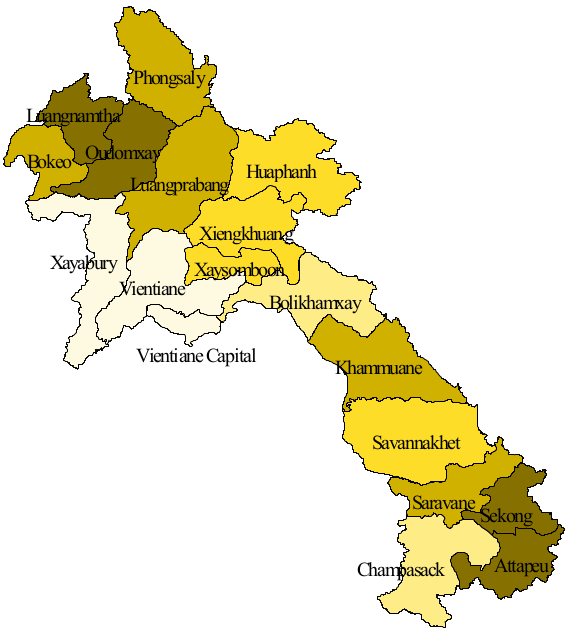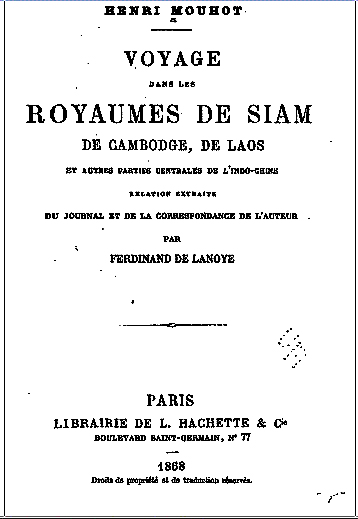|
Ban Phanom
Ban Phanom is a village in Luang Prabang Province, Laos. It is located east of Luang Prabang. The Lue people, Lue peoples of this village are noted in particular for their cotton and silk weaving. Sale to tourists is now of prime importance to the local economy. Nearby is the Tomb of Mouhot, where Henri Mouhot lies. References External linksVideo {{Laos-geo-stub Populated places in Luang Prabang Province ... [...More Info...] [...Related Items...] OR: [Wikipedia] [Google] [Baidu] |
Provinces Of Laos
Laos, officially the ''Lao People's Democratic Republic'', is divided into 17 provinces ( Lao ແຂວງ, , , or ) and one prefecture, the Vientiane capital city municipality (ນະຄອນຫຼວງ, nakhon louang, or ''Na Kone Luang Vientiane''). The special administrative zone (ເຂດພິເສດ, ''khet phiset''), Xaisomboun, created in 1994, was dissolved on 13 January 2006. In 2013, parts of the former special administrative zone was reestablished as Xaisomboun province. Provinces and prefectures of Laos Population The population of each province in 2015 is given in the census data. History In 1989 Vientiane prefecture was split from Vientiane province and the capital of Vientiane province moved from Vientiane to Muang Phôn-Hông. In 1994 Xaisômboun khetphiset (special region) was formed from parts of the Bolikhamxai, Vientiane, and Xiangkhoang provinces. In 2006 Xaisomboun special region was dissolved and the Longsan, Xaysomboun, Phun, and Hom dist ... [...More Info...] [...Related Items...] OR: [Wikipedia] [Google] [Baidu] |
Districts Of Laos
Laos is divided into 17 provinces ( Lao: ແຂວງ, '' khoueng'') and 1 prefecture (''kampheng nakhon''), or capital city municipality (ນະຄອນຫລວງ, '' nakhon luang''). Furthermore, 1 so-called special administrative zone (ເຂດພິເສດ, '' khet phiset'') existed between 1994 and 2006, when it was re-merged into its surrounding provinces (i.e. Vientiane and Xiangkhoang). The Xaisomboun special administrative zone was later recreated as the 17th province. Each province is subdivided into districts ( Lao: ເມືອງ, ''mueang'') and then subdivided into villages ( Lao: ບ້ານ, ''baan''). Districts of Laos :Note — Each district has a code in parentheses displaying the first two digits as the province and the last two as the district representing that province. References External links * * Laos Ministry of Education district maps [...More Info...] [...Related Items...] OR: [Wikipedia] [Google] [Baidu] |
Laos
Laos (, ''Lāo'' )), officially the Lao People's Democratic Republic ( Lao: ສາທາລະນະລັດ ປະຊາທິປະໄຕ ປະຊາຊົນລາວ, French: République démocratique populaire lao), is a socialist state and the only landlocked country in Southeast Asia. At the heart of the Indochinese Peninsula, Laos is bordered by Myanmar and China to the northwest, Vietnam to the east, Cambodia to the southeast, and Thailand to the west and southwest. Its capital and largest city is Vientiane. Present-day Laos traces its historic and cultural identity to Lan Xang, which existed from the 14th century to the 18th century as one of the largest kingdoms in Southeast Asia. Because of its central geographical location in Southeast Asia, the kingdom became a hub for overland trade and became wealthy economically and culturally. After a period of internal conflict, Lan Xang broke into three separate kingdoms: Luang Phrabang, Vientiane and Champasak. In ... [...More Info...] [...Related Items...] OR: [Wikipedia] [Google] [Baidu] |
Luang Prabang
Luang Phabang, ( Lao: ຫລວງພະບາງ/ ຫຼວງພະບາງ) or ''Louangphabang'' (pronounced ), commonly transliterated into Western languages from the pre-1975 Lao spelling ຫຼວງພຣະບາງ (ຣ = silent r) as Luang Prabang, literally meaning " Royal Buddha Image", is a city in north central Laos, consisting of 58 adjacent villages, of which 33 comprise the UNESCO ''Town Of Luang Prabang'' World Heritage Site.Application of Information and Communication Technology to Promote Sustainable Development A Case Study: Town of Luang Prabang, Lao PDR (pdf) Tokyo Institute of Technology, Retrieved June 15, 2016 It was listed in 1995 for unique and "remarkably" well preserved architectur ... [...More Info...] [...Related Items...] OR: [Wikipedia] [Google] [Baidu] |
Lue People
The Tai Lü people ( Tai Lue: ᦺᦑᦟᦹᧉ, , ''Dǎi lè'', lo, ລື້, ''Lư̄'', th, ไทลื้อ, , vi, Người Lự) are an ethnic group of China, Laos, Thailand, Burma and Vietnam. They speak a Southwestern Tai language. Etymology The word ''Lü'' (ລື້) is similar to the ''Lao people'' in the Tai Lü language. Tai Lü can be written as Tai Lue, Dai Le and Dai Lue. They are also known as Xishuangbanna Dai, Sipsongpanna Tailurian and Tai Sipsongpanna. The word ''Lue'' (Thai: เหนือ Tai Lue: ᦟᦹᧉ) in the Tai languages means "north", thus their ethnonym means ''Northern Tai'' which they share with Tai Nua people. Distribution In Vietnam, most Lu live in Lai Châu Province and their population was 5,601 in 2009. In China, they are officially recognized as part of the Dai ethnic group. The 2000 census counted about 280,000 Dai people speaking Lü language. The population in Thailand, where they are called Thai Lue ( th, ไทลื้� ... [...More Info...] [...Related Items...] OR: [Wikipedia] [Google] [Baidu] |
Tomb Of Mouhot
Alexandre Henri Mouhot (May 15, 1826 — November 10, 1861) was a French naturalist and explorer of the mid-19th century. He was born in Montbéliard, Doubs, France, near the Swiss border, but spent his childhood in Russia and, possibly, parts of Asia. He died near Naphan, Laos. He is remembered mostly in connection to Angkor. Mouhot's tomb is located just outside of Ban Phanom, to the east of Luang Prabang. Early life He traveled throughout Europe with his brother Charles, studying photographic techniques developed by Louis Daguerre. In 1856, he began devoting himself to the study of Natural Science. Upon reading "The Kingdom and People of Siam" by Sir John Bowring in 1857, Mouhot decided to travel to Indochina to conduct a series of botanical expeditions for the collection of new zoological specimens. His initial requests for grants and passage were rejected by French companies and the government of Napoleon III. The Royal Geographical Society and the Zoological Society ... [...More Info...] [...Related Items...] OR: [Wikipedia] [Google] [Baidu] |
Henri Mouhot
Alexandre Henri Mouhot (May 15, 1826 — November 10, 1861) was a French naturalist and explorer of the mid-19th century. He was born in Montbéliard, Doubs, France, near the Swiss border, but spent his childhood in Russia and, possibly, parts of Asia. He died near Naphan, Laos. He is remembered mostly in connection to Angkor. Mouhot's tomb is located just outside of Ban Phanom, to the east of Luang Prabang. Early life He traveled throughout Europe with his brother Charles, studying photographic techniques developed by Louis Daguerre. In 1856, he began devoting himself to the study of Natural Science. Upon reading "The Kingdom and People of Siam" by Sir John Bowring in 1857, Mouhot decided to travel to Indochina to conduct a series of botanical expeditions for the collection of new zoological specimens. His initial requests for grants and passage were rejected by French companies and the government of Napoleon III. The Royal Geographical Society and the Zoological Society of ... [...More Info...] [...Related Items...] OR: [Wikipedia] [Google] [Baidu] |

.jpg)

